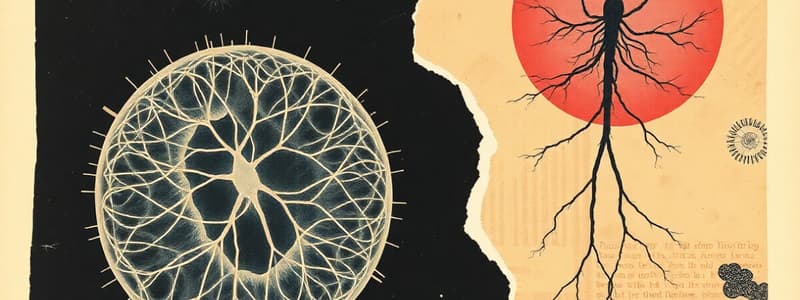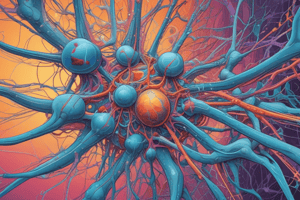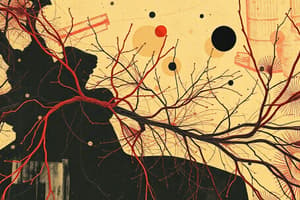Podcast
Questions and Answers
The ______ are known as the power generating units of the cells.
The ______ are known as the power generating units of the cells.
mitochondria
The ______ is a network of tubular and flat vesicular structures in the cytoplasm.
The ______ is a network of tubular and flat vesicular structures in the cytoplasm.
endoplasmic reticulum
The ______ are membrane-enclosed sacs responsible for packaging and modifying proteins.
The ______ are membrane-enclosed sacs responsible for packaging and modifying proteins.
Golgi bodies
Lysosomes are irregular structures surrounded by a ______ membrane.
Lysosomes are irregular structures surrounded by a ______ membrane.
The ______ functions in the detoxification of harmful substances and the metabolism of fatty acids.
The ______ functions in the detoxification of harmful substances and the metabolism of fatty acids.
The membrane-bound structure that contains enzymes responsible for digestion and recycling of cellular components is called a ______.
The membrane-bound structure that contains enzymes responsible for digestion and recycling of cellular components is called a ______.
Peroxisomes are involved in the breakdown of fatty acids and the detoxification of ______.
Peroxisomes are involved in the breakdown of fatty acids and the detoxification of ______.
In eukaryotic cells, the ______ serves as a framework for the cell that helps maintain its shape and aids in cellular movement.
In eukaryotic cells, the ______ serves as a framework for the cell that helps maintain its shape and aids in cellular movement.
The primary function of organelles in a cell is to ______ specific tasks that are vital for the cell's health and function.
The primary function of organelles in a cell is to ______ specific tasks that are vital for the cell's health and function.
The ______ function of the nucleus is to control cellular activities and store genetic information.
The ______ function of the nucleus is to control cellular activities and store genetic information.
Flashcards are hidden until you start studying
Study Notes
FUNCTIONS OF CELLULAR ORGANELLES
- Mitochondria serve as power-generating units, crucial for energy transduction via respiration and thermogenesis.
- Mitochondria regulate calcium ion concentrations in various cell compartments.
ENDOPLASMIC RETICULUM (ER)
- Composed of a network of tubular and flattened vesicular structures known as cisternae.
- Contains an Endoplasmic Matrix within its tubules.
- Divided into two main types:
- Smooth Endoplasmic Reticulum (SER)
- Lacks ribosomes.
- Synthesizes lipids and steroid hormones.
- Predominantly found in cells involved in lipid production, such as adipocytes and adrenal cortex cells.
- Rough Endoplasmic Reticulum (RER)
- Contains ribosomes for protein synthesis.
- Primarily responsible for synthesizing proteins, processing, and packaging.
- Located in protein-secreting cells, such as pancreatic acinar cells and plasma cells.
- Smooth Endoplasmic Reticulum (SER)
- Functions include protein segregation, unsaturation of fatty acids, and muscle contraction.
- Often referred to as sarcoplasmic reticulum in muscle fibers.
GOLGI BODIES
- Comprised of multiple stacked layers of membrane-bound sacs adjacent to the nucleus.
- Contains distinct compartments organized into four functional regions: cis Golgi network, Golgi stack, and trans Golgi network.
- Function as the cell's wrapping and packaging department.
- Involved in producing secretion granules that store hormones and enzymes in protein-secreting cells.
- Facilitates the formation of lysosomes and adds carbohydrates to proteins, creating glycoproteins essential for tissue formation.
LYSOSOMES
- Diameter ranges from 250 to 750 nm and consists of irregular structures surrounded by a membrane.
- Contain enzymes for degrading cellular waste, making them crucial for cellular digestion and recycling.
CYTOSOL
- The aqueous medium of the cytoplasm outside organelles, accounting for nearly 70% of total cell volume.
- Composed of cytoskeleton filaments, organic molecules, salts, and water.
- Contains unique proteins and chemical elements vital for cellular metabolism.
ORGANELLES
- Key organelles in the cytoplasm include mitochondria, endoplasmic reticulum, lysosomes, Golgi apparatus, peroxisomes, and vacuoles.
- Each organelle is enclosed by a lipid membrane and performs specific biological functions.
MITOCHONDRIA
- First observed by Kolliker in 1850, recognized as the "powerhouse of the cell."
- Morphology includes outer and inner membranes, an intermediate space, cristae, and an inner matrix.
- Outer membrane contains porins, allowing passage for small molecules.
- Inner matrix is the site for the citric acid cycle and respiratory chain oxidation processes.
- Involved in ATP synthesis and metabolism of carbohydrates, lipids, and amino acids.
- Contains mitochondrial DNA which encodes some mitochondrial proteins.
NUCLEUS
- Houses chromatin, RNAs, and nuclear proteins in an aqueous environment.
- Organizes genetic material and localizes nuclear functions via a matrix of nuclear lamins.
- Chromatin is associated with lamins, facilitating structural integrity and gene regulation.
NUCLEAR ENVELOPE
- Composed of two membranes and a nuclear lamina, with nuclear pore complexes facilitating transport.
- Outer membrane connects with the endoplasmic reticulum, facilitating communication.
- Penetrable primarily to small nonpolar molecules, providing a selective barrier.
CELLULAR FUNCTIONS
- The nucleus acts as both a repository for genetic information and a control center for gene expression, allowing complex regulation mechanisms such as posttranscriptional regulation.
- Each cellular compartment performs distinct metabolic functions, ensuring proper cellular operation and homeostasis.
Studying That Suits You
Use AI to generate personalized quizzes and flashcards to suit your learning preferences.




